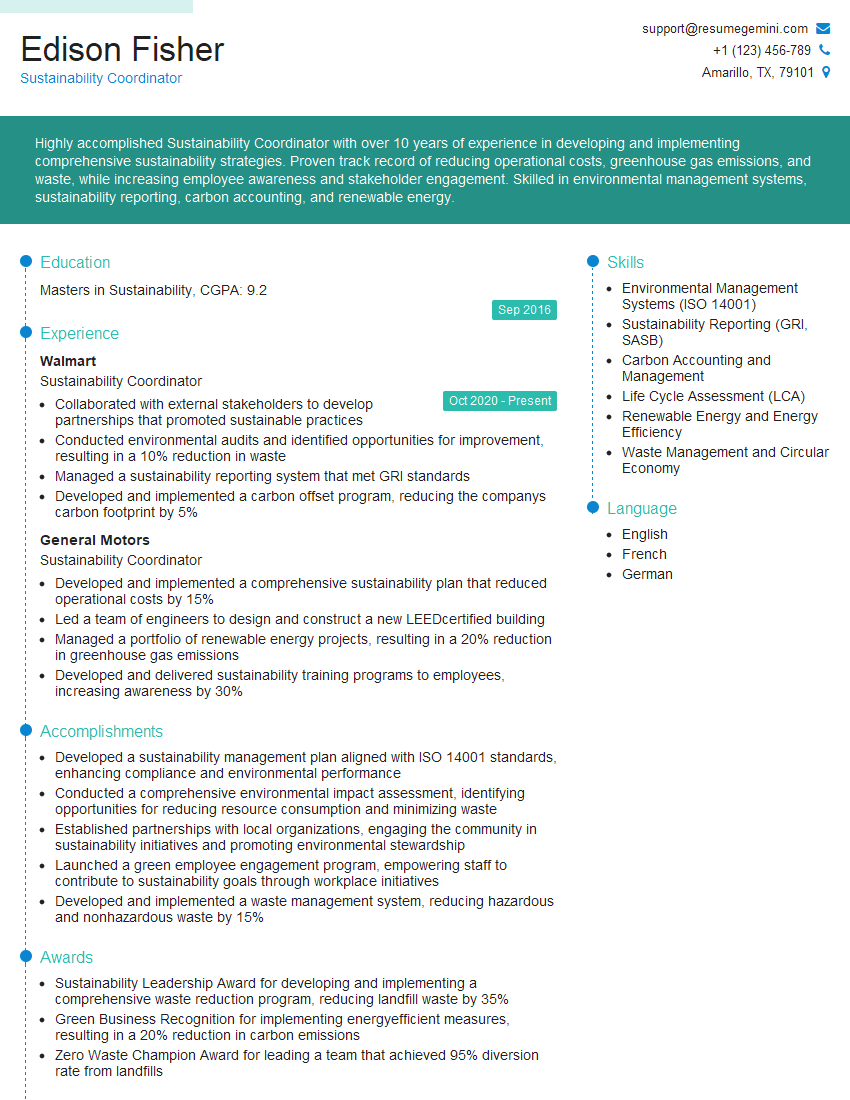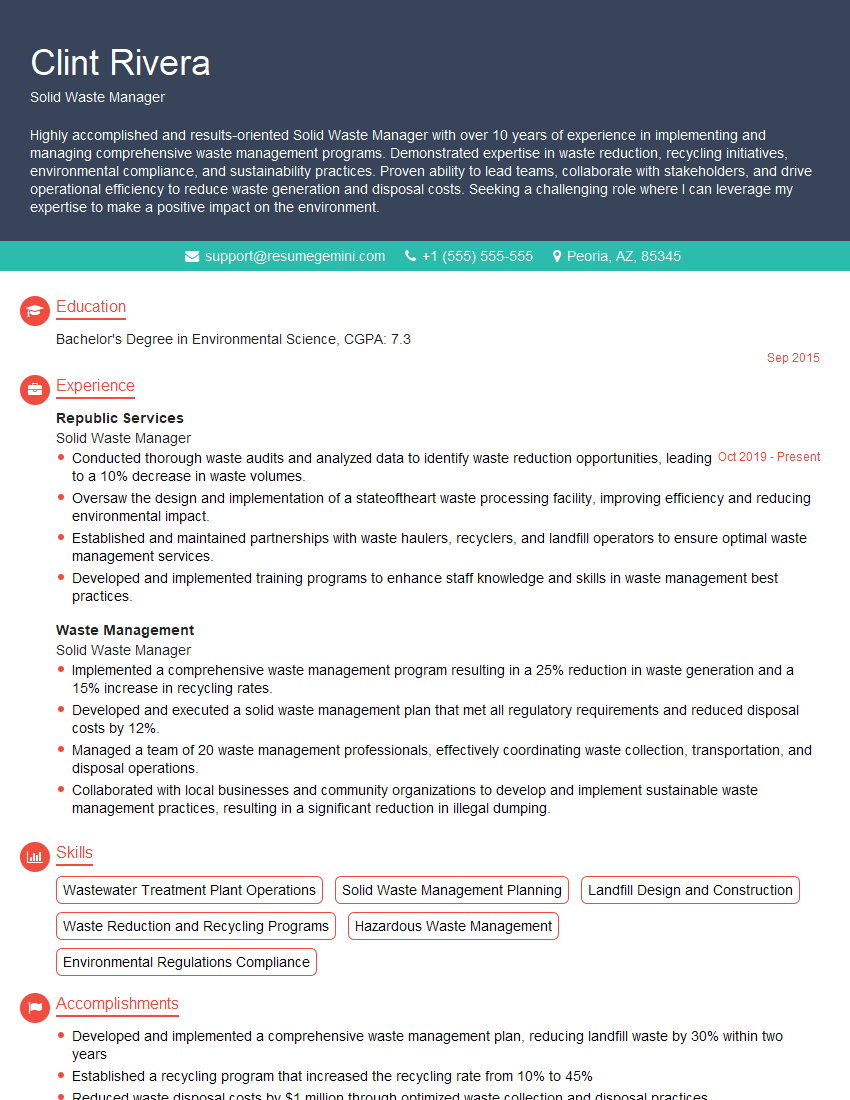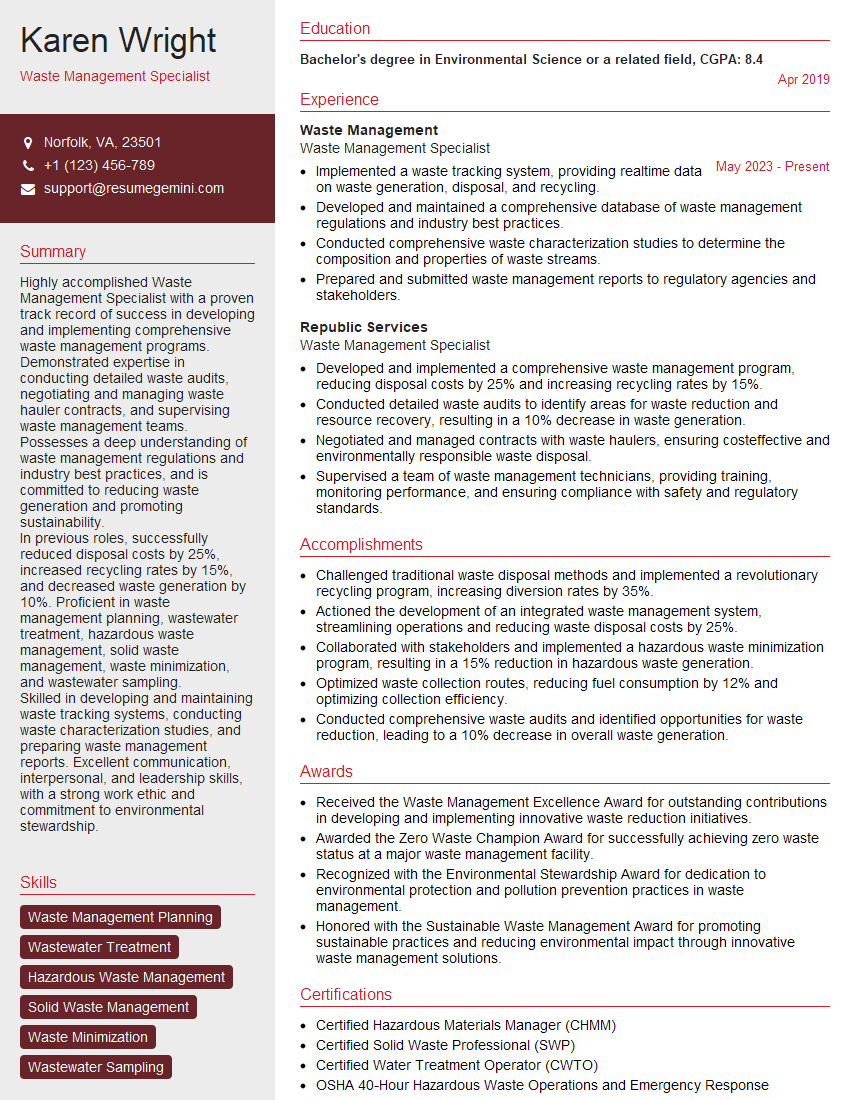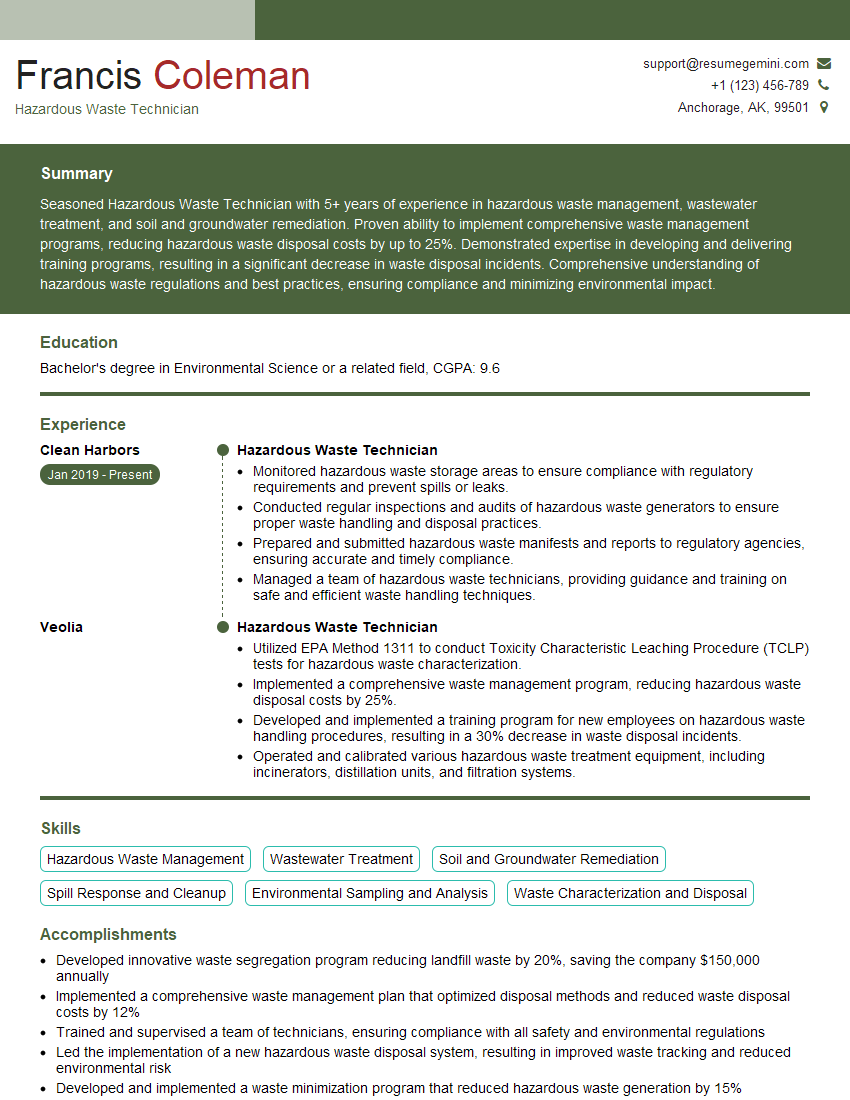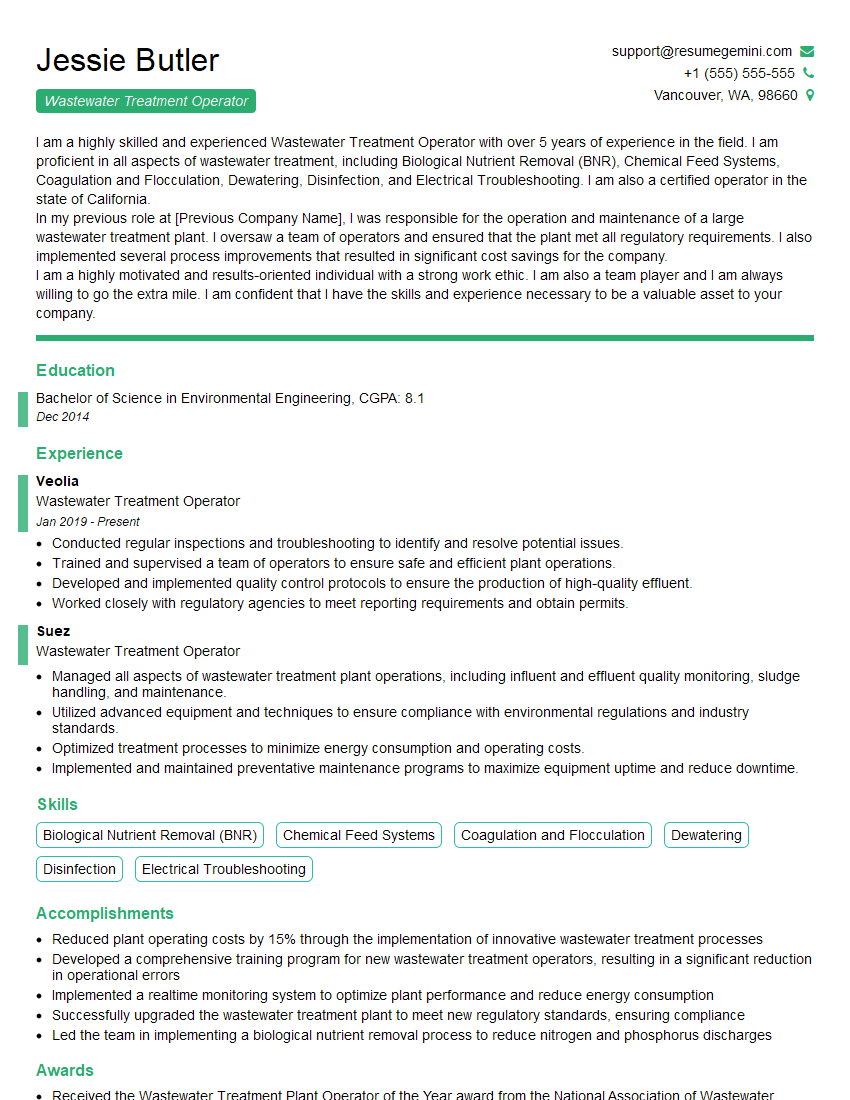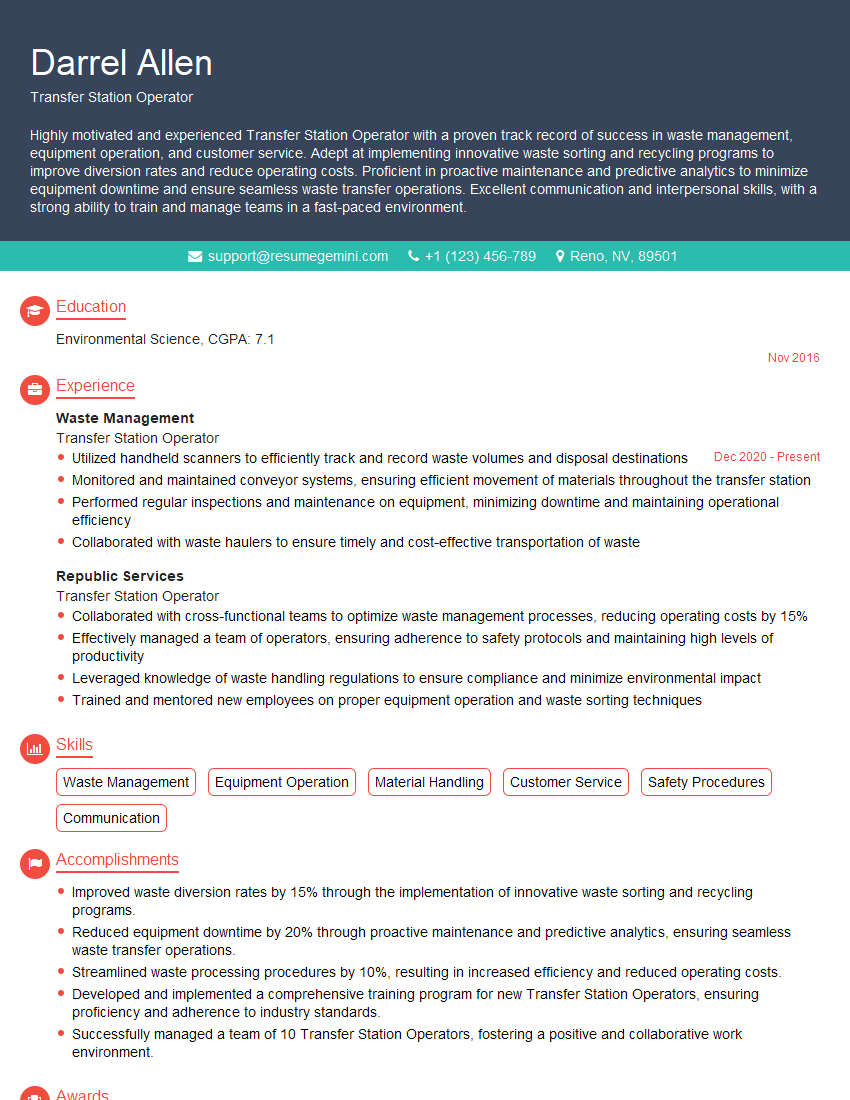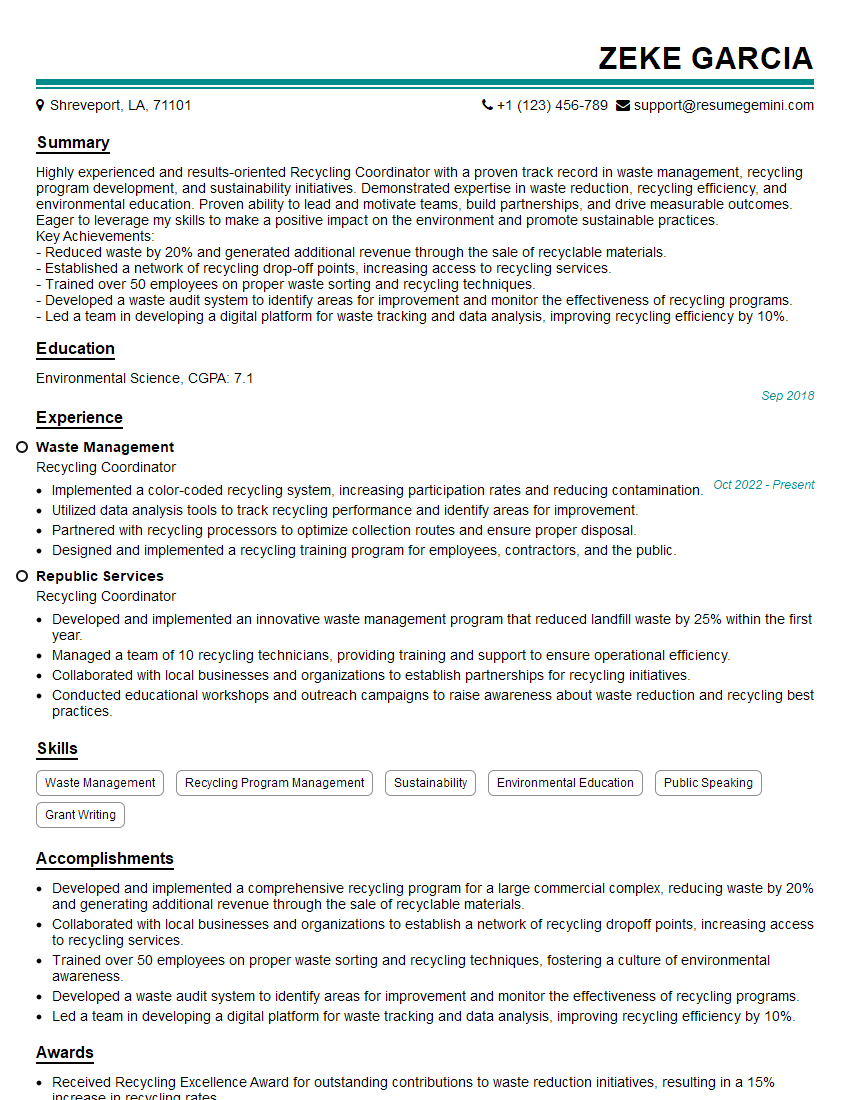Cracking a skill-specific interview, like one for Attention to detail and accuracy in waste disposal operations, requires understanding the nuances of the role. In this blog, we present the questions you’re most likely to encounter, along with insights into how to answer them effectively. Let’s ensure you’re ready to make a strong impression.
Questions Asked in Attention to detail and accuracy in waste disposal operations Interview
Q 1. Describe your experience in sorting and classifying different types of waste materials.
Sorting and classifying waste is the cornerstone of efficient and responsible waste management. It involves meticulously separating waste streams into different categories based on their composition and potential for recycling, reuse, or disposal. My experience encompasses working with a wide range of materials, from common recyclables like paper, plastic, and glass, to more complex items like hazardous waste, e-waste, and organic materials.
For example, in my previous role at Green Solutions, we utilized a multi-stage sorting process. First, we had a pre-sorting line where larger items were manually separated. Then, the remaining waste moved to an automated system with conveyor belts and optical sorters that identified different materials by their composition and color. Finally, a manual quality control check ensured accurate classification before the materials were sent to their designated recycling or disposal facilities. This layered approach minimized contamination and maximized the efficiency of the recycling process. We tracked each material’s weight and volume, allowing us to continually optimize our sorting strategies and improve our overall recycling rate.
- Paper and Cardboard: Sorted by type (newspaper, cardboard, office paper) to ensure appropriate recycling processes.
- Plastics: Categorized by resin type (e.g., PET, HDPE, PP) and color to ensure compatibility with different recycling streams.
- Metals: Separated into ferrous (iron, steel) and non-ferrous (aluminum, copper) categories for efficient metal recovery.
- Glass: Classified by color (clear, green, brown) to maintain the quality of recycled glass.
Q 2. How do you ensure accurate record-keeping in waste disposal operations?
Accurate record-keeping is crucial for maintaining compliance, tracking waste streams, and optimizing waste management strategies. This involves diligently documenting every stage of the waste handling process, from waste generation to final disposal. In my work, we utilize a comprehensive digital tracking system that integrates with barcode scanners and weighing scales. This system allows for real-time data entry and minimizes human error.
Each waste stream is assigned a unique identifier, and all transactions are logged, including the type of waste, quantity, date, time, source, and destination. We regularly conduct internal audits to ensure data accuracy and integrity. Regular reports are generated, summarizing waste generation, recycling rates, and disposal costs. These reports help us to identify areas for improvement and inform decision-making related to waste reduction and resource management. A crucial part of this process is the use of standardized waste manifests which accompany shipments of waste to ensure traceability and accountability throughout the supply chain. Any discrepancies are immediately investigated and resolved.
Q 3. Explain your process for identifying and handling hazardous waste materials.
Identifying and handling hazardous waste requires a high level of expertise and strict adherence to safety protocols. My process begins with a thorough waste characterization, identifying potential hazards based on physical, chemical, and biological properties. This often involves consulting Safety Data Sheets (SDS) to understand the specific hazards associated with each material. We utilize standardized hazard classification systems, such as the Globally Harmonized System of Classification and Labelling of Chemicals (GHS).
Hazardous wastes, once identified, are segregated from other waste streams and stored in appropriately labelled containers that are designed to prevent leaks and spills. These containers are stored in designated areas, following strict safety regulations. Transportation and disposal of hazardous waste are outsourced to licensed and permitted hazardous waste handlers. All procedures are documented meticulously, including the handling, storage, transportation, and disposal of the hazardous waste. We maintain detailed records of all hazardous waste generators, quantities, and disposal methods, ensuring full compliance with environmental regulations.
For example, identifying a leaking container of corrosive acid immediately triggers a containment procedure, involving specialized personnel and equipment to neutralize the acid and clean the affected area. Following this, the incident is documented, and the root cause is analysed to prevent similar situations in the future.
Q 4. What methods do you employ to minimize waste generation and maximize recycling rates?
Minimizing waste generation and maximizing recycling rates are paramount to sustainable waste management. My approach integrates several strategies, focusing on waste reduction at the source, improved recycling practices, and promoting responsible consumption. This involves collaborating with waste generators to implement source reduction strategies, such as promoting reusable containers, reducing packaging, and implementing efficient procurement practices.
We employ advanced sorting and processing technologies to maximize the recovery of recyclable materials. We are constantly evaluating and implementing new technologies to improve our separation and sorting processes to enhance the quality of recycled materials. For instance, we recently implemented a new automated sorting system that uses advanced sensors to identify and sort plastics with greater accuracy, leading to a significant increase in our recycling rates. Public awareness campaigns and educational programs play a vital role in changing consumer behavior and promoting recycling participation. We actively engage with the community through educational events and workshops to promote responsible disposal habits and the importance of resource conservation.
Q 5. How do you ensure compliance with all relevant environmental regulations and permits?
Compliance with environmental regulations and permits is non-negotiable. We maintain a robust compliance program that ensures adherence to all applicable local, state, and federal regulations. This involves regularly reviewing and updating our procedures to reflect changes in regulations. Our waste management practices are aligned with the relevant environmental laws and regulations, ensuring that all our operations are carried out legally and responsibly.
We maintain up-to-date records of all permits and licenses, and we undergo regular inspections and audits to ensure compliance. We actively participate in industry associations and stay updated on the latest regulatory changes. We have a designated compliance officer who is responsible for monitoring our compliance and reporting any potential non-compliances. Proactive compliance not only prevents penalties but also fosters environmental stewardship and builds public trust.
Q 6. Describe a situation where your attention to detail prevented a safety hazard or environmental incident.
During a routine inspection of a storage area for chemical waste, I noticed a slight discoloration on the label of a container of highly flammable solvent. While the label was still legible, the discoloration suggested possible degradation of the container. My attention to this seemingly minor detail led to the immediate removal and proper disposal of the container. A more thorough examination revealed a minor crack, potentially leading to a significant safety hazard or an environmental spill. This highlighted the importance of proactive monitoring and meticulous attention to detail, preventing a potentially serious incident.
Q 7. How do you handle discrepancies or errors in waste manifests or tracking systems?
Discrepancies in waste manifests or tracking systems necessitate immediate investigation. Our protocol involves a multi-step process. First, we identify the nature and extent of the discrepancy. Then, we trace the waste back to its origin to determine the source of the error. We may need to review the original waste generation records, weigh bills, and transportation documents to reconcile the information. If the discrepancy involves a hazardous waste shipment, we immediately notify the relevant authorities, such as the Environmental Protection Agency (EPA). Following the investigation, a comprehensive report is generated detailing the discrepancy, its cause, and the corrective actions taken to prevent future occurrences. We update our records and take corrective actions as needed. Internal audits and regular system checks help minimize these discrepancies and enhance the accuracy of our tracking systems.
Q 8. What are the common causes of inaccuracies in waste disposal operations, and how do you mitigate them?
Inaccuracies in waste disposal stem from various sources, impacting efficiency and environmental compliance. Common causes include inadequate training of personnel leading to misclassification of waste, poorly designed waste streams resulting in contamination, lack of proper labeling and segregation, malfunctioning weighing equipment, and insufficient record-keeping.
Mitigation strategies involve comprehensive employee training programs emphasizing proper waste sorting, clear labeling systems with visual aids and multilingual support, regular equipment calibration and maintenance schedules, and the implementation of robust digital record-keeping systems. For instance, we can use color-coded bins with clear labels and provide regular refresher training with hands-on practice to ensure that everyone understands the procedures. We can also install automated weighing systems with data logging capabilities to eliminate manual errors.
Implementing a system of regular audits, both internal and potentially external, provides a crucial layer of oversight to identify and rectify any deviations from established protocols. This proactive approach minimizes risks and ensures the accuracy of the entire waste disposal process.
Q 9. Explain your understanding of different waste disposal methods (landfilling, incineration, recycling, etc.).
Waste disposal methods vary significantly based on the type of waste and local regulations. Landfilling involves burying waste in designated areas, a cost-effective but environmentally concerning method due to potential leachate and greenhouse gas emissions. Incineration involves burning waste at high temperatures, reducing volume but potentially releasing harmful air pollutants if not properly managed. Recycling processes sort and reprocess materials into new products, reducing landfill burden and conserving resources. Composting is a biological process that decomposes organic waste into a nutrient-rich soil amendment. Anaerobic digestion breaks down organic matter in the absence of oxygen, generating biogas (a renewable energy source) and digestate (fertilizer).
Each method has its advantages and disadvantages. The choice depends on a cost-benefit analysis considering factors such as environmental impact, energy recovery potential, regulatory compliance, and public health concerns. For example, a mixed waste stream might require a combination of recycling (for plastics and metals), composting (for food scraps), and incineration (for non-recyclable materials) with energy recovery for an optimal and sustainable approach.
Q 10. How do you prioritize tasks to ensure timely and accurate waste disposal operations?
Prioritizing tasks in waste disposal operations requires a structured approach to ensure timely and accurate disposal. I utilize a system that combines urgency, impact, and regulatory compliance. I start by identifying time-sensitive tasks, such as handling hazardous waste or addressing immediate spills. Next, I prioritize tasks with the highest environmental impact, such as preventing contamination or managing large waste volumes. Finally, I ensure adherence to all relevant regulations and legal requirements.
Using a Kanban board or similar visual management tool allows me to track progress and dynamically adjust priorities as needed. This flexibility is crucial as unexpected situations, like equipment malfunctions or a sudden influx of waste, frequently arise. For example, if a hazardous material spill occurs, that immediately takes precedence over routine tasks. This systematic approach ensures efficient operations and prevents delays or errors.
Q 11. Describe your experience with using waste management software or tracking systems.
I have extensive experience with various waste management software and tracking systems. I’ve worked with systems ranging from simple spreadsheet-based solutions to sophisticated enterprise resource planning (ERP) systems integrated with waste tracking modules. These systems typically allow for real-time monitoring of waste generation, tracking waste movement throughout the facility, generating reports on waste composition and disposal costs, and managing compliance with regulatory requirements.
For example, I’ve used software that integrates with barcode scanners to track individual waste containers, automatically generating reports on their weight, contents, and destination. This level of detailed tracking improves accuracy significantly and provides valuable data for improving operational efficiency and reducing costs. The key benefits include reduced manual data entry, increased data accuracy, and streamlined reporting, leading to better decision-making and enhanced environmental compliance.
Q 12. How do you ensure the accurate weighing and measurement of waste materials?
Accurate weighing and measurement of waste are critical for billing, reporting, and environmental compliance. We achieve accuracy through a multi-pronged approach. Firstly, we use calibrated scales that are regularly maintained and verified. Secondly, we establish standardized procedures for weighing, including pre-tare checks to ensure accurate weight measurements. Thirdly, we implement double-checking procedures whenever possible, involving two individuals independently verifying the weight of each load before final disposal.
For extremely large or irregularly shaped loads, specialized equipment like load cells integrated with weighbridges might be necessary. Furthermore, using automated weighing systems with data logging directly reduces human error and ensures reliable records. Maintaining detailed logs of all weighing and measurement activities enables traceability and provides vital information for audits and reporting.
Q 13. What is your understanding of waste stream audits and their importance?
Waste stream audits are a systematic evaluation of the types and quantities of waste generated by a facility or organization. They’re vital for identifying opportunities for waste reduction, improving recycling rates, optimizing waste disposal strategies, and ensuring regulatory compliance. An audit involves a detailed analysis of the waste composition, flow, and handling processes. Data is collected through various methods, including visual inspection, sampling, and weighing of waste streams.
The information obtained helps to pinpoint areas for improvement. For instance, an audit may reveal that a significant portion of waste is recyclable but improperly sorted, or that a specific type of waste can be reduced through process optimization. By identifying these inefficiencies, we can implement targeted strategies for waste reduction, recycling, and proper disposal, resulting in significant environmental and financial benefits.
Q 14. How do you communicate effectively with colleagues and supervisors regarding waste disposal procedures?
Effective communication is paramount in ensuring safe and accurate waste disposal operations. I prioritize clear, concise, and timely communication with colleagues and supervisors. I use a variety of methods including daily briefings, written reports, email updates, and visual aids. When dealing with potential hazards or deviations from protocol, I immediately inform my supervisor and relevant personnel. This ensures prompt action and prevents potential accidents or environmental incidents.
I utilize clear and simple language, avoiding jargon, ensuring that everyone understands the information being shared. In addition, I always confirm that instructions have been understood and that everyone is on the same page. Regular team meetings provide opportunities for discussions, feedback, and the clarification of any uncertainties or concerns, fostering a collaborative work environment and enhancing the overall effectiveness of the waste disposal operations.
Q 15. Describe your experience with training others on safe waste handling practices.
Training others on safe waste handling is crucial for maintaining a safe and compliant workplace. My approach involves a multi-faceted strategy combining theoretical knowledge with hands-on practical application. I begin with a comprehensive overview of relevant regulations and company policies, emphasizing the importance of each procedure. This is followed by interactive sessions demonstrating proper techniques for handling various waste types – from hazardous materials to recyclable items. I use visual aids like diagrams and videos to reinforce key points and conduct regular quizzes to assess understanding. Finally, I incorporate supervised practical training where individuals apply learned techniques under my guidance, providing immediate feedback and correction as needed. For example, when training on sharps disposal, I demonstrate proper needle recapping techniques and the use of puncture-resistant containers, emphasizing the importance of preventing needlestick injuries.
Furthermore, I emphasize the consequences of improper waste handling, including environmental damage, health risks, and potential legal ramifications. Creating a culture of safety and accountability is paramount. Post-training evaluations and follow-up sessions ensure ongoing adherence to best practices and allow for addressing any remaining knowledge gaps.
Career Expert Tips:
- Ace those interviews! Prepare effectively by reviewing the Top 50 Most Common Interview Questions on ResumeGemini.
- Navigate your job search with confidence! Explore a wide range of Career Tips on ResumeGemini. Learn about common challenges and recommendations to overcome them.
- Craft the perfect resume! Master the Art of Resume Writing with ResumeGemini’s guide. Showcase your unique qualifications and achievements effectively.
- Don’t miss out on holiday savings! Build your dream resume with ResumeGemini’s ATS optimized templates.
Q 16. How do you handle situations where equipment malfunctions affect waste disposal operations?
Equipment malfunctions can significantly disrupt waste disposal operations, creating safety hazards and potentially leading to non-compliance. My immediate response is to prioritize safety – immediately securing the affected area, alerting relevant personnel, and ensuring no one approaches the malfunctioning equipment. Next, I assess the nature of the malfunction and its potential impact. A minor issue, like a jammed compactor, might require simple troubleshooting steps, while a more serious problem, such as a leak in a hazardous waste container, necessitates immediate professional repair and potentially emergency response procedures.
I maintain detailed records of all equipment maintenance and repairs, including the dates, nature of the problem, and the actions taken. This data assists in identifying potential patterns of equipment failure, allowing for proactive maintenance and minimizing future disruptions. In the case of a major malfunction, I collaborate with maintenance personnel and, if necessary, regulatory agencies to ensure the safe containment and disposal of affected waste materials. This process involves documenting every step, ensuring full compliance with all relevant safety and environmental regulations. For instance, if a chemical spill occurs, we’d immediately contain the spill, notify emergency services, and follow the specific protocols outlined in our safety data sheets and emergency response plan.
Q 17. What are the key performance indicators (KPIs) you use to monitor the efficiency and accuracy of waste disposal?
Key Performance Indicators (KPIs) are essential for measuring the effectiveness and accuracy of waste disposal operations. We monitor several metrics, including:
- Waste Diversion Rate: This measures the percentage of waste diverted from landfills through recycling, composting, or other recovery methods. A higher rate indicates greater efficiency in resource management.
- Compliance Rate: This tracks the percentage of waste disposal activities that adhere to all relevant environmental regulations and company policies. 100% compliance is the ultimate goal.
- Incident Rate: This tracks the number of accidents, injuries, or near misses related to waste handling per employee-hour worked. A low rate signifies a safe working environment.
- Waste Processing Time: This measures the time taken to process and dispose of waste. Efficient processes minimize delays and costs.
- Cost per Ton Processed: This reflects the overall cost-effectiveness of waste disposal operations.
Regularly analyzing these KPIs enables us to identify areas for improvement, optimize processes, and ensure continuous compliance and safety. For example, if the waste diversion rate is consistently low, we might investigate ways to enhance our recycling programs or improve employee training on waste segregation.
Q 18. How do you stay updated on changes in environmental regulations and best practices for waste disposal?
Staying current with evolving environmental regulations and best practices is critical in the waste disposal industry. I utilize several methods to ensure continuous learning and compliance:
- Subscription to industry publications and newsletters: This provides access to the latest news, research, and regulatory updates.
- Participation in professional development workshops and conferences: These events offer valuable networking opportunities and exposure to innovative techniques and technologies.
- Active membership in professional organizations: Organizations like the [Insert relevant professional organization] provide access to resources, training, and networking opportunities.
- Regular review of government websites and regulatory documents: This ensures adherence to all relevant laws and guidelines.
I also maintain a comprehensive library of relevant documents and regularly update internal training materials to reflect the most current information. For example, changes to hazardous waste regulations necessitate immediate updates to our handling procedures and employee training programs. Staying informed and proactive in this area is essential for maintaining compliance and protecting the environment.
Q 19. Describe a time you had to deal with a complex or unexpected waste disposal challenge.
One challenging situation involved the discovery of an improperly labeled container of unknown chemical waste. The initial label was illegible and incomplete, making identification impossible. Following our safety protocols, I immediately isolated the container and contacted a hazardous waste specialist. While waiting for the specialist, I rigorously documented the situation, including photographs and detailed notes on the container’s location, physical characteristics, and any potential surrounding hazards. The specialist conducted a thorough analysis to determine the composition of the waste, enabling safe and compliant disposal following established procedures. This experience reinforced the crucial need for precise waste labeling, robust emergency response plans, and close collaboration with hazardous waste experts.
The incident led to an internal review of our labeling procedures, resulting in strengthened guidelines and improved employee training to prevent similar occurrences. We implemented a stricter verification process for all incoming waste, incorporating double-checking mechanisms and improved record-keeping. This incident highlighted the importance of proactive risk assessment, detailed documentation, and ongoing training for handling unexpected challenges within waste disposal operations.
Q 20. How do you ensure the proper labeling and segregation of waste materials?
Proper labeling and segregation of waste materials are essential for efficient and safe disposal. Our system relies on a clearly defined waste stream categorization based on material type (e.g., paper, plastic, glass, hazardous waste) and regulatory requirements. We use color-coded bins and labels that are standardized across the facility to minimize confusion. Labels clearly indicate the type of waste, any relevant hazard warnings (e.g., biohazard, corrosive), and any specific handling instructions. All containers are clearly marked with their contents, date, and the generator’s name. This system aids in traceability and simplifies the sorting and disposal process.
Employee training is crucial for successful implementation. Regular refresher courses reinforce the importance of accurate labeling and proper segregation. We use visual aids like posters, diagrams, and interactive training modules to make the information easily accessible and understandable. Regular audits and inspections ensure consistent adherence to our labeling and segregation procedures. Inconsistencies are immediately addressed through retraining and process improvements. For example, any improperly labeled waste is immediately flagged, its contents identified, and corrective actions taken to improve training or processes as necessary.
Q 21. What safety protocols do you follow when handling different types of waste?
Safety protocols vary significantly depending on the type of waste handled. Our procedures are aligned with OSHA and EPA guidelines, and include:
- Personal Protective Equipment (PPE): Appropriate PPE, such as gloves, safety glasses, respirators, and protective clothing, is mandatory when handling any type of waste, with the specific PPE determined by the hazard class of the waste.
- Engineering Controls: Engineering controls like ventilation systems, containment areas, and spill kits minimize exposure risks.
- Administrative Controls: Procedures, training, and emergency response plans are critical administrative controls that mitigate risk.
- Hazardous Waste Handling: For hazardous waste, rigorous procedures are followed, including specialized containers, documented handling logs, and adherence to specific transportation and disposal regulations.
- Sharps Disposal: Strict protocols for handling sharps (needles, syringes) involve the use of puncture-resistant containers and proper disposal methods to prevent needlestick injuries.
- Infectious Waste: Handling infectious waste requires strict adherence to biohazard protocols, including autoclaving or incineration, depending on the type of waste and local regulations.
Regular safety training and drills ensure that all personnel are well-versed in the appropriate protocols for all waste types. This includes emergency response plans and procedures for dealing with spills or unexpected events.
Q 22. How do you ensure the safe and proper disposal of confidential or sensitive waste?
Safe disposal of confidential waste begins with a robust process from the point of generation. We use clearly marked, tamper-evident containers specifically designated for sensitive materials. These containers are often locked and tracked, ensuring accountability throughout the process. For example, in a previous role, we used color-coded bags for different sensitivity levels—red for highly confidential, yellow for moderately confidential, and clear for non-confidential waste. The disposal company we contracted with had their own chain of custody procedures, including secure transportation and certified destruction methods, such as incineration or shredding, ensuring data irrecoverability. This includes regular audits of the process and employee training on proper handling procedures to reinforce the importance of data protection.
Q 23. Describe your experience with waste audits and identifying areas for improvement.
Waste audits are crucial for optimizing waste management practices. My experience involves conducting both pre and post-collection audits to identify areas for improvement. Pre-collection audits typically involve reviewing waste generation data and site visits to assess current waste segregation and handling practices. Post-collection audits involve analyzing the waste streams at the disposal facility, looking for discrepancies or contaminants that indicate issues with segregation at the source. For instance, in one audit, we discovered a significant amount of recyclable material improperly disposed of in the general waste stream. This led to a targeted training program for staff and improved signage to clearly label waste bins. The results? A significant reduction in landfill waste and an increase in recycling rates. We also use data analysis to track trends and ensure continuous improvement.
Q 24. How do you contribute to a culture of safety and compliance within a waste disposal team?
Fostering a culture of safety and compliance requires a multi-pronged approach. It starts with clear communication of safety procedures and regulations, using accessible language and practical examples. Regular training, including refresher courses and hands-on demonstrations, ensures everyone understands their responsibilities and how to identify and report hazards. I strongly advocate for open communication—encouraging team members to voice concerns and participate actively in safety discussions. We used a system of near-miss reporting where any potential incidents were thoroughly investigated and used as learning opportunities. Finally, recognizing and rewarding safe work practices reinforces positive behavior and creates a more engaged team. For instance, in a past role, we created a ‘Safety Star’ award program which significantly boosted team morale and proactive identification of safety hazards.
Q 25. Explain your understanding of waste reduction strategies and their implementation.
Waste reduction strategies aim to minimize the amount of waste generated in the first place, focusing on the ‘reduce, reuse, recycle’ hierarchy. This involves implementing source reduction strategies at the point of generation, promoting reusable products and containers, and optimizing recycling programs. An example is implementing a robust composting program for organic waste, diverting it from landfills and reducing greenhouse gas emissions. Another is a detailed inventory of the materials we use and exploring more sustainable alternatives, and even exploring zero-waste initiatives where feasible. Successful implementation involves a collaborative effort: engaging employees, educating stakeholders, and closely monitoring waste generation data to assess the effectiveness of different strategies. Regular evaluation and adaptation based on the data collected are key to continuous improvement.
Q 26. How do you handle customer complaints or concerns related to waste disposal services?
Handling customer complaints requires a calm, empathetic, and efficient approach. I begin by actively listening to the customer’s concerns, acknowledging their frustration, and ensuring they feel heard. Then, I gather all relevant information to understand the issue fully—for example, location, type of waste, and dates involved. A thorough investigation follows, involving reviewing our service records and perhaps visiting the site if necessary. Once the cause is identified, I offer a clear explanation, propose a solution, and follow up to ensure their satisfaction. In instances where a service failure occurred, I’d offer appropriate compensation and implement corrective actions to prevent similar incidents in the future. Good communication and prompt resolution are paramount to maintain a positive customer relationship.
Q 27. What are your strategies for preventing cross-contamination of different waste streams?
Preventing cross-contamination is vital to ensure the effectiveness of waste management and to comply with regulations. This starts with clear labeling and segregation of waste streams. We utilize color-coded bins and clear signage, and training helps employees understand the differences between waste types. Regular inspections of waste storage areas help to identify any issues quickly. Specialized containers or liners for hazardous waste prevent leakage and contamination of other materials. For example, we’d use puncture-resistant containers for sharps, separate containers for infectious waste, and sealed containers for chemicals. Thorough cleaning and disinfection of bins and equipment is also essential to minimize the risk of cross-contamination.
Q 28. Describe your experience with emergency response procedures related to waste disposal incidents.
Emergency response procedures are critical for handling unforeseen incidents, such as spills or equipment malfunctions. My experience involves implementing and regularly reviewing our emergency response plan. This includes identifying potential hazards, establishing clear communication channels, designating roles and responsibilities for the team, and outlining step-by-step procedures for different scenarios. For instance, we have specific protocols for handling chemical spills, involving immediate containment, notification of relevant authorities, and utilizing specialized equipment. Regular drills and training exercises help the team to react effectively and safely in an emergency. Post-incident reviews analyze the events, identify areas for improvement, and adjust the plan accordingly to ensure ongoing preparedness and prevent future incidents. Documentation of these procedures is meticulously maintained and regularly updated.
Key Topics to Learn for Attention to Detail and Accuracy in Waste Disposal Operations Interview
- Waste Stream Segregation: Understanding different waste types (hazardous, recyclable, organic, etc.) and proper sorting procedures. This includes knowledge of local regulations and company-specific protocols.
- Compliance and Regulations: Familiarity with relevant environmental laws, safety standards (OSHA, etc.), and waste disposal permits. This involves understanding the consequences of non-compliance.
- Equipment Operation and Maintenance: Safe and efficient operation of waste handling equipment (e.g., compactors, balers, trucks). This includes preventative maintenance procedures and recognizing potential malfunctions.
- Record Keeping and Documentation: Accurate and meticulous record-keeping of waste quantities, disposal methods, and tracking of materials. This includes understanding data entry best practices and maintaining audit trails.
- Safety Procedures: Thorough understanding of safety protocols for handling various waste types, including personal protective equipment (PPE) requirements and hazard identification.
- Problem-Solving and Troubleshooting: Ability to identify and resolve issues related to waste disposal processes, including dealing with equipment malfunctions or unexpected waste materials.
- Waste Minimization Strategies: Knowledge of techniques and best practices for reducing waste generation at the source, promoting recycling and reuse initiatives.
- Environmental Impact: Understanding the environmental consequences of improper waste disposal and the importance of sustainable waste management practices.
Next Steps
Mastering attention to detail and accuracy in waste disposal operations is crucial for career advancement in this field. It demonstrates your commitment to safety, environmental responsibility, and efficient operations. This skillset is highly valued by employers and opens doors to greater responsibilities and higher earning potential. To maximize your job prospects, creating an ATS-friendly resume is essential. ResumeGemini is a trusted resource to help you build a professional and impactful resume that highlights your skills and experience effectively. Examples of resumes tailored to showcasing attention to detail and accuracy in waste disposal operations are available to help you get started.
Explore more articles
Users Rating of Our Blogs
Share Your Experience
We value your feedback! Please rate our content and share your thoughts (optional).
What Readers Say About Our Blog
Live Rent Free!
https://bit.ly/LiveRentFREE
Interesting Article, I liked the depth of knowledge you’ve shared.
Helpful, thanks for sharing.
Hi, I represent a social media marketing agency and liked your blog
Hi, I represent an SEO company that specialises in getting you AI citations and higher rankings on Google. I’d like to offer you a 100% free SEO audit for your website. Would you be interested?
